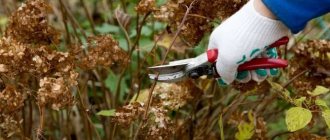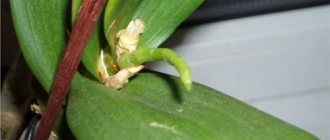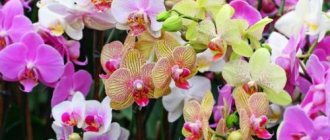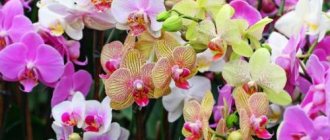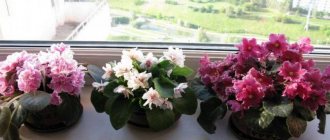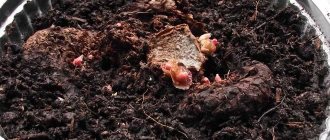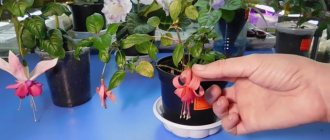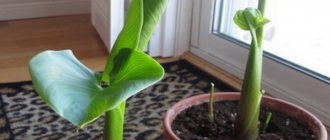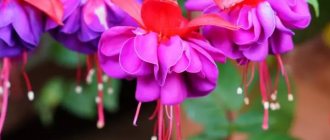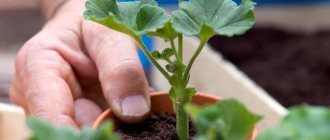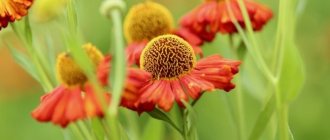Proper care of fuchsia in winter at home involves a number of activities. They are aimed at preparing the flower for the cold, properly preserving it and bringing it back to life with the onset of spring. Fuchsia is the subject of worship and adoration of most gardeners. This plant looks bright, striking everyone with its rich palette of colors and originality of shape. Fuchsia belongs to the category of perennial evergreen shrubs of the Fireweed family. This plant is native to South America. Thanks to its beauty and ease of care, it is incredibly popular among gardeners around the world. Today science knows several hundred species of this shrub growing in the wild. The plant easily tolerates transportation. It is equally well suited for life in a garden and a city apartment. Particularly appreciated by flower lovers is the fact that with good care, fuchsia can live for more than 50 years.
Preparing fuchsias for winter: do they need to be fertilized?
There is no point in fertilizing fuchsia in the fall. At this time, plants go dormant and practically stop consuming nutrients from the soil. At the end of October - beginning of November, before frosty weather sets in, fuchsias are watered, trimmed and placed in this state in a basement or cellar, without removing them from pots or tubs.
If fuchsias grew simply in the ground, they are dug up along with a lump of earth, several are placed in one container, the roots are sprinkled with additional soil, the soil is moistened and also put into the cellar for storage.
Pests and diseases
Healthy plants should have healthy leaves without spots. If the leaves begin to fall off, dry out, or spots appear on them, you should inspect the plant. Such problems may indicate pests or fuchsia diseases that have settled.
Among the pests, whiteflies, white fly larvae, and spider mites can settle on the leaves of the flower. You can get rid of them with the help of Actellik, Angara or other insecticides.
Of the diseases, fuchsia most often affects:
- Chlorosis is manifested by dryness and yellowing of foliage. The cause of the disease is a lack of manganese or frequent watering during the dormant period. The plant is watered with potassium permanganate and watering is reduced.
- Powdery mildew appears in the form of powdery gray spots when the soil is too wet. Topaz or Fundazol will help cure the plant.
- Rust is a dangerous infectious disease. It appears as brown dry spots on the underside of the leaf blades. The affected leaves need to be torn off, and the bush should be treated with Bordeaux mixture three times every ten days.
Fuchsia is affected by diseases mainly due to poor-quality soil and care errors. In order for the “Japanese lantern” to delight you with its beautiful and abundant flowering during cultivation, strictly follow all the rules for caring for fuchsia at home.
Why you can’t send fuchsias for the winter without pruning
A radical fuchsia haircut in the fall is simply necessary. A summer resident may want to leave a plant that is still green, and possibly blooming if it was in a greenhouse, without pruning. But under no circumstances should you do this.
Red and white sponge cake with coconut cream: a holiday dessert recipe
A three-meter crocodile was caught from a residential area in Florida (video)
The dissatisfied simply left: how the poor defended their rights in Ancient Rome
Flowers on fuchsia bushes appear on the shoots of the current season. If the plant is not pruned, in the spring it will produce very few new branches, and, accordingly, the summer resident will not see flowering.
Fuchsias: description and photos of varieties for growing at home
Indoor fuchsia is a plant with flowing shoots, bright green oval leaves and delicate flowers of a wide variety of colors. The flowers have an unusual structure - they have a tubular corolla, delicate petals and long stamens. When the petals open, the flowers look like bell flowers or dancing ballerinas in a fluffy skirt. The buds can have a wide variety of colors. Their petals can be white, blue, orange, lilac, pink, violet, and even bicolor or tricolor.
Depending on the variety, fuchsia flowers form and bloom at different times of the year. Some species decorate apartments in winter with their blooms.
At home, hybrid varieties are grown in the form of a bush or hanging plant.
Popular bush fuchsia hybrids:
- Talia is a plant with bright orange flowers.
- Henriette Ernst - the variety is distinguished by light lilac petals and scarlet sepals.
- Anabel is a bush or ampelous hybrid with double, large, white buds.
- Alissol Bell is a plant with spectacular semi-double buds of red-violet color.
- Armbrough Campbell - this variety is distinguished by double flowers that bloom in winter, which consist of soft pink petals and red narrow sepals.
Ampelous varieties of indoor fuchsia:
- Imperial Crown is a plant with raceme-shaped inflorescences, which consist of scarlet elongated flowers.
- Blue Angel is a hybrid popular due to its white sepals, against which the lilac-violet petals look beautiful.
- Prince of Peace is a variety with red petals and white sepals.
- Hollis Beauty - the plant is distinguished by white and pink double flowers.
Temperature changes
Fuchsias are pruned some time before they are to be put into the cellar. It costs longer to keep pruned plants, for example, in a greenhouse for adaptation before they are placed in the cellar for the winter. But only if there is no strong warming or, conversely, cooling outside. Temperature changes have a very negative effect on pruned plants. Fuchsias may “cry”, and this will most likely lead to the fact that the plants will not survive the winter.
Do I need to trim?
Pruning fuchsia for the winter is a must . This is a very important stage in growing fuchsia. Do it twice a year:
- In the fall, when they move the flower to the basement or apartment.
- In spring, to form a beautiful bush.
In order not to provoke the growth of trunks and stretching of the bush upward, fuchsia is pruned in the fall immediately after flowering. The procedure is necessary for proper development in the spring.
How to cut your hair correctly
Fuchsia should be cut short. Green branches that have not yet become lignified should be removed. They can be used to propagate fuchsias by cuttings. The same applies to crooked shoots, too thin or growing inside the bush. They need to be removed from the plant with a sharp pruning shears disinfected in a solution of potassium permanganate. The remaining branches are cut to a length of 20-30 cm. After pruning, about 3-5 of the strongest and healthiest short branches should remain in the ampelous fuchsia bush. Up to 6-10 branches are left on standard plants.
Apple will release its new iPhone 13 at the end of September
Pastel and favorite jeans: trendy spring looks to lift your spirits
Malakhov refused his Moscow registration and registered in the city of Apatity
Growing from seeds
It is recommended to propagate fuchsias by seeds from February to April. You can sow seeds in ready-made soil purchased at the store or prepare the soil yourself from the following ingredients:
- coarse washed sand – 1 share;
- peat – 2 shares;
- turf substrate - 3 shares.
The soil should be nutritious and light. Before use, it is frozen on the balcony or in the freezer. If this is not possible, then water the soil with boiling water. Sow the seeds in wide, shallow containers with drainage holes. The bottom of the container is first filled with drainage, then with soil, which is watered with a weak solution of potassium permanganate. The seeds are evenly distributed over the soil surface and sprayed with water from a spray bottle. There is no need to embed them in the soil. For better seed germination, the containers are covered with film on top and placed in a warm, bright place. You need to make sure that they are not exposed to direct sunlight.
You will be interested to know: What and how to feed geranium in the fall at home after pruning and if the pelargonium is still blooming
When caring for crops, the soil is kept moist, but not wet. The film is removed for a while every day so that the soil is ventilated and does not turn sour.
In about fifteen to twenty days, shoots will appear. They are gradually accustomed to home conditions, removing the shelter every day. Water the seedlings carefully using a spray bottle or pipette.
When two true leaves appear on the seedlings, they are planted in disposable cups with a volume of 100 or 200 ml. They should be watered moderately after the top layer of the substrate has dried. Every two weeks, young plants are fed with complex fertilizers.
When the cups for the bushes become small, they are transplanted into pots two centimeters larger than the old container.
When fuchsias become elongated, it is recommended to shorten their tops. Then the bush will turn out lush and strong.
Fuchsia grown at home from seeds will begin to bloom in two years.
If there is no cellar
If there is no cellar or cold basement in the house, fuchsias can be stored in trenches in winter. In this case, a long hole, called a kagat, 60-80 cm deep is dug in the ground. Fuchsias in this case are also pruned. Then the plants are placed in a trench on their side directly in the pots and covered with straw, dry grass or leaf humus. Such an insulating layer should have a thickness of at least 5-10 cm. Earth is poured on top of the straw.
It is allowed to make such a trench directly in the garden. In this case, it is covered with snow on top. Also, some summer residents store fuchsias in winter in piles dug inside the greenhouse. In this case, after filling with earth, the hole is additionally covered with spunbond.
Preserving plants in the basement and cellar
To preserve fuchsia in the cold season, it would be advisable to place it in the basement. But we should not forget that before moving the plant, it is necessary to shorten the leaves. In the absence of light, the plant breathes in the same way as in open space, that is, useful elements are consumed. The room should be well ventilated, otherwise humidity will rise, which will cause fungus.
Important!
The best temperature for fuchsia in the basement is at least +10 degrees.
Wintering indoors
If there are few fuchsias in the garden, but there is no cellar, they can be taken into the house or city apartment for the winter. When the air temperature in winter is above +18 ° C, in order for fuchsias to overwinter well and bloom luxuriantly the next season, the air humidity in the room where they are located must be raised. To do this, pots of fuchsias are placed on trays with wet pebbles. In the room itself, place an air humidifier or place containers with water. The air humidity in a room with wintering fuchsias at temperatures above 18 ° C should be 50-60%. If the temperature is lower, there is no need to additionally humidify the air in the room.
Hormones are restored: scientists explained the healing power of hugs
Pastels and flowers: how to wear the most fashionable shades and prints of spring for women 50+
Look stylish: how to decorate flower pots in an antique style
How to protect yourself from diseases in your apartment in winter?
If the rules for creating favorable wintering conditions are violated, the plant is often susceptible to a fungal disease called rust.
It occurs if the room temperature is too high and light is low, as well as due to excessive watering. To prevent the pathogenic fungus from touching the fuchsia, it should be treated with a 1% solution of Bordeaux mixture. This procedure will protect the flower from the appearance of brown and brown spots on the leaves, which destroy the plant. If you detect the fungus at first, you can save the fuchsia with a disinfectant mixture that contains water, green soap and copper sulfate.
In winter, the ballerina is susceptible to gray rot , the appearance of which is provoked by high humidity in the room. The disease is easy to identify by the affected areas: they are soft and watery, and there is a white coating on the surface of the leaves. The plant is treated with special preparations and mandatory changes in the microclimate in order to prevent re-infection of the plant.
Basic winter care tips
Basic recommendations for organizing proper wintering of fuchsias:
- the room should be dry, cool and fresh, but not warm and humid - this is detrimental to plants;
- Both over-humidified and over-dried air are unacceptable;
- “dormant” fuchsias should not be left without proper care - they require constant attention;
- constant ventilation and an influx of fresh air is an indispensable condition for successful wintering;
- unconditional compliance with agricultural cultivation techniques and care rules.
LiveInternetLiveInternet
My wintering option: leave the fuchsias on the glassed-in loggia for the winter! Of course, you will have to prepare a little for such a step :) First of all, I want to immediately make it clear that my recommendations apply to those balconies that do not face the north side. Even a few hours of sun at this time works wonders. In addition, even in frosty weather, the sun can heat our small “greenhouse” to May temperatures, solving the problem of saving energy during the daytime. So, many plants (including my beloved fuchsias and geraniums) require cool conditions in winter. Much cooler than you think! When you leave a warm room onto the loggia, it will seem to you that it is simply frosty there! However, if you look at the thermometer, you will find as much as 6°C! And this is quite enough to make the flowers feel completely happy! Moreover, if you hang several thermometers in different corners and at different heights, you will be surprised how different the temperature can be (the difference can be up to 10°C!). I have three thermometers: one in the coldest place - near the window; the second one is in the middle of the balcony at a height of approx. 70 cm from the floor (just under the boxes with plants); and one on the inside wall, above the plants. I mainly focus on the temperature of the second thermometer (on average, 4-8°C is enough, but it’s okay if it drops to zero or even a little lower for a short period of time). At the top the temperature can be 10-17°C. What needs to be done to maintain the desired temperature? 1. Properly insulate all windows. Arm yourself with caulk and seal all the cracks in and around the windows. It would be nice to have double frames. But for three years in a row (until I installed double glass), I solved this problem with the help of double film for greenhouses - simply the entire wall from top to bottom is clogged with a single piece of such film. The disadvantage of this method is that from November to April you cannot open the windows (in my case this is very inconvenient, since almost all the windows in the apartment face exactly this loggia). Its advantage is simplicity and cheapness! The partition under the frames can be upholstered with any insulation. I don’t insulate the floor at all - I just laid linoleum and rugs so that it wouldn’t be cold to walk on. If everything is well insulated, then even without additional heating the difference between internal and external temperatures will be approx. 10°C (i.e. if it’s zero outside, it’s 10°C inside, and if it’s -10°C outside, it’s time to think about heating). I use a regular electric heater (and then only in cold weather and at night: during the day, if no one is home, it is quite enough to simply open the balcony door so that the heat from the room enters the loggia). 2. Minimal watering is required - once or twice a week. I water with warm water (I pour a kettle of boiling water into a bucket of settled water), only slightly wetting the ground. Fertilizer should be kept to a minimum from November to February. 3. I bury pots with plants in boxes with sawdust: in addition to increasing humidity in the summer, this promotes thermal insulation (from overheating in summer and from cooling in winter). The drawers are located on the inside of the loggia near the warm wall. Under the pots that stand on the windowsills, I place pieces of thick polystyrene foam in frosty conditions (in very severe frosts, I completely remove them from the windowsill). Despite the apparent coolness, plants grow well during this period and gain green mass. Rooted cuttings develop well. Flowering ends by the end of November and begins again in February. In the period from November to February, I rarely go out onto the balcony, because I leave work when it’s still dark, and I come when it’s already dark. By the way, I recommend making lighting on the loggia (not to illuminate the plants, but for the convenience of caring for them). During this period, you can focus your unfulfilled need to nurture something on growing seedlings from seeds and cuttings in your apartment (this is where lighting comes in handy), which in February can already be taken out onto the loggia, and by April-May it will bloom! From the beginning of February I begin replanting, fertilizing, crown formation, in general - the usual pleasant routine - the season can be considered open! What I would like to draw your attention to is the steady shift of winter towards spring in recent years. What is not very good for us, because... slows down development and delays flowering. In March and April it is still cold and there is little light. It’s warm in January, the flowers have already softened and prepared for spring - and then the February frosts await them! In February you need to be especially careful. You may even have to bring some of the flowers into the apartment for a while. If the frost is short-lived - up to a week, then the heater copes. But then the walls of the house begin to freeze, and then it’s time to take action. But you have three thermometers (don't you?) - you can tell which flowers to remove and which ones can handle themselves.Wintering on a windowsill (advice from club members)
Not all fuchsia lovers can create ideal cool wintering conditions for their plants. Based on your numerous requests, I turned to the club members with a request to reveal their secrets of wintering fuchsias on the windowsills of ordinary city apartments. 1
“Almost all indoor plants have a period of deep dormancy throughout the year, which usually occurs in winter. Fuchsias show unmistakable signs of slow growth. And your task is only to not interfere with their rest and create favorable conditions for this. In a room with central heating in the middle of winter, the air can be as dry as the Sahara. Very few plants tolerate such conditions well. However, my fuchsias overwinter at room temperature quite well. They stand on the windowsills, where it is cooler and lighter. I can’t say that I water fuchsias regularly, most likely, as needed. The water temperature should be the same as the air temperature. I don’t feed fuchsias in winter at all; I try to provide them with a humid atmosphere by placing them in the kitchen, perhaps in the bathroom (if the size of the room allows this) or in a terrarium (applies to small specimens). Having an aquarium next door increases humidity very well. You can use a humidifier, but I use regular spraying with boiled water at room temperature. This water does not leave traces of salts on the leaves, which are found in large quantities in tap water. You can also group plants (by doing this we increase the area of evaporation). There is another possibility - the so-called double pot. Place flower pots in another larger container, and fill the space between them with hygroscopic material, and always keep it moist. I use sphagnum moss. This creates a microclimate around the plants, while the air in the room remains dry. It is also useful to place fuchsias on a low tray, in which a layer of pebbles is poured. It can be made from any waterproof material. The depth of the tray is about 5cm, the length and width can be any. Place a layer of small pebbles 2-2.5 cm thick on the bottom of the tray and pour in enough water to wet the bottom pebbles. The water should not completely cover the pebbles. Place pots of fuchsias on top of the stones. If the fuchsia is large enough (for example, the Voodoo variety can reach 1.5 m), then it is best to place a tray with pebbles on the floor under the central heating radiator. With this placement, the air humidity around the plants will increase many times. Do not overdo it, remember that too humid air contributes to the occurrence of fungal diseases. Air humidity should be between 60-70%. As for autumn pruning for winter, the approach to each specimen is individual. It all depends on the state of fuchsia. If your pet has grown a lot over the summer and stretched out, then you can trim it a little and straighten its hair. The main thing is not to get carried away. Global pruning in winter is done in cases where your fuchsia is going to spend the winter in a cool basement, where there is not enough heat and light. You send it there to hibernate until spring. I don’t recommend doing this when wintering in a warm apartment. The conditions in the apartment are such that fuchsia will still grow. Heavy pruning can damage fuchsia, since for the plant to develop normally, a balance must be maintained between the crown and root system. Leaves provide roots with energy obtained through photosynthesis. If the root system is powerful, then the foliage of heavily pruned fuchsia will not be able to fully provide the necessary amount of energy to the root. Fuchsia will try to acquire the missing green mass, which is difficult for it to do in winter due to the short daylight hours. As a result, individual roots die off. The plant ceases to resist diseases and loses strength. But if your hands are itching to do a lot of pruning or the fuchsia is in such a state that amputation is necessary, then this should be done as early as possible so that by the dormant period it has restored the necessary balance between the tops and roots. Or replant and prune both top and bottom at the same time. But this is no longer a question of wintering on the windowsill, but rather of rejuvenation and rehabilitation of the fuchs. » 2
“I don’t consider myself an experienced Fuchsist. All summer my fuchsias live on the open balcony. They really like it there, so they are in no hurry to return to the room. But gradually it becomes colder and, depending on the temperature, at the very end of September I bring them into the room. Sometimes they live in the air until the beginning of October. The signal for relocation is usually the first frost. There is no need to deposit earlier. My fuchsias always overwinter on the windowsill. I don't do anything special with them. If any of them have become very stretched over the summer, I prune them a little. I water it moderately. In winter they sleep with me. And they simply don’t need any additional lighting. The main thing, in my opinion, at this time is not to drown. But what I would advise others to do is to insulate the window sill. Otherwise, no matter how you insulate the frames, the pots will still be icy and the roots will freeze. I insulate it very simply and reliably. I use foam ceiling tiles. All the stores are full of them, they cover the ceilings with them. I line the windowsill with it and use it to protect the pots - I place the tiles vertically along the glass. You can simply glue the joint with tape, but it is not necessary. That's all. The pots are always warm, and no cold is scary - these tiles are a wonderful insulator. I usually start disturbing my sleeping beauties around February. I give them new hairstyles - I cut them off. Now, what suits whom? And if cuttings are needed, then the entire “cutting” should be placed in water. They take root well at this time. It is clear that they begin to wake up at the same time. Can you sleep here if they're cutting your hair?! Tell them kindly: “Hello, my beauties! Happy spring to you!” And you will see - they will understand!..” 3
“Even though I’ve been working on fuchsias for a long time, I can’t say anything meaningful, much less worthy of an article, about wintering. Some of the fuchsias are on the window sills, some are under lighting (see the article about lighting below), and I am simply updating some. Fuchsias behave best under lighting, and they also survive pruning best. I try to prune those fuchsias that are on the windowsill at the beginning of October so that they have time to produce full-fledged shoots, and not such frail ones as winter ones, or I don’t prune them at all until February. In February I do radical pruning (I select the lowest viable node on the branch, preferably with leaves, and prune above it). Circus regularly dies in winter, for reasons unknown to me, so I keep two copies of it. The white and pink American one is also capricious. By the way, since I purchased the moisture meter, the fuchsias practically do not die, and we survived this summer without a single loss. :) I bought it after I completely switched to German soil and watered the plants several times. It has a three-color scale, which, accordingly, shows three levels of soil moisture: dry, wet, waterlogged. You immerse the metal pin into the ground, the arrow on the scale shows the level of moisture. This is how we fight.”
Artificial lighting
To highlight fuchsias, I use OSRAM Fluora mercury lamps. I have two lamps, each of which has two tubes about 1m 20 cm long installed. (The lamp is the most common, long rectangle, in offices on ceilings they are something like this, imported ones will be prettier than ours, they come with two and one lamp) One lamp is installed above the usual one table-book, assembled. The height from the table surface to the lamp is about 30 cm. The lighting area is approximately 1 m 20 cm x 35 cm. If you use single lamps, you can increase the width; I plan to install two single lamps on the rack. Approximately 6 - 8 adult fuchsias fit, quite wide; if they are small, then there is another row, and under them you can put any low-growing plants.
Garden under the lamp |
I use this installation for rooting cuttings and growing them, and here I give the plant its shape: I prefer compact fuchsias in the form of small bushes, and here I wait for the buds to set. The lower the lamp, the more compact the plant will be. Ideally, you need a lamp with height adjustment, because... fuchsias grow very quickly, but I have never seen such lamps in Moscow. If they exist, then the price is probably accordingly. You have to adjust the height using all sorts of improvised methods, such as: placing pots on all sorts of jars, flasks, pots. This, of course, does not look very aesthetically pleasing. Buds are formed if the lamp is on for at least 12 hours. If you do not want the fuchsia to bloom, but only want it to overwinter, you need to increase the distance from the plant to the lamp and make the daylight hours shorter. When the fuchsia is formed, the buds have appeared and grown, I move the plant to the windowsill. Exactly the same lamp is attached there, but at a distance of about 50 cm from the window sill. That's where the fuchsias bloom. The window is east, the sun goes down at 14:00, then the lamp turns on. I tried installing regular fluorescent lamps on the window. The result is negative - all the buds have fallen off. The disadvantage of this lamp is the inability to open the window. Of course, the use of lamps is only justified if you live on the lower floors in dark apartments. Then fuchsias will delight you with their blooms all year round. But in the summer I definitely put them on the balcony and update them every year, because... Over the summer, the plant quickly loses its compactness. The disadvantages of growing fuchsias under lights are the same as when growing them on a hot summer day. There are a lot of buds, fuchsia flowers lose their fullness and become smaller due to abundant flowering, light varieties have intensified color on the inside of the upper petals, dark varieties (red, dark pink top) can turn out to be poorly colored, white varieties, on the contrary, acquire a pinkish tint. In winter, due to low air humidity, flowers may open with already dried stamens. The soil dries out very quickly. In addition, when using such lamps it is difficult to think through the interior. Right now I'm planning to dedicate one or two shelves to flowers (not just fuchsias) on the shelving in the living room. But, given the rapid growth of fuchsia, its presence on this rack will continue only until it loses its aesthetic appearance. And because fuchsias grow very quickly, they won’t last long to show off in the living room. Ampelous varieties of light varieties are more suitable than others for growing on shelves in rooms where guests are received. If there is enough light, then I would not recommend using lamps. There is nothing better than natural light. But for wintering and germinating cuttings, lamps are very convenient.
Source: fuchsias.ru
Houseplant – fuchsia
The homeland of all types of fuchsia flowers is Central and South America, as well as New Zealand. Fuchsias are evergreen shrubs. They gained particular popularity due to the unusual shape of their flowers. Their petals are much smaller in size than the leaves of the corolla calyx and stamen, due to which the flower takes on a “bristle” appearance. In color theory, “fuchsia” is usually called a light pink-violet shade; but true fuchsia flowers can have different colors, even black and dark blue. After flowering, berry-like fruits appear that can be eaten. Among the fuchsias there are both small trees and hanging plants.
There is also a chemical compound “fuchsin”, also named after this plant; its aqueous solution has a purple-red color, similar to the flowers of many types of fuchsias.
The history of the discovery and study of these plants is quite romantic. She is associated with the famous 17th century French botanist Charles Plumier, who took part in a grand expedition to the West Indies and was the discoverer of many new plants. Among them were fuchsias, which he named in honor of Leonard von Fuchs, a 16th-century German scientist considered the founder of botany as such. In the next, eighteenth century, this name was used by Carl Linnaeus, the great Swedish scientist who officially introduced modern nomenclature into biology; that is why Linnaeus, and not Plumier, is considered the author of the botanical name of the genus Fuchsia.
There are, however, alternative versions of the discovery of this flower. According to one of them, when Plumier brought this plant to Europe, their relatives were already decorating one of the botanical gardens in England, where George Handisid brought them from the shores of the Strait of Magellan. Another version states that the discoverer of fuchsias was Leonard von Fuchs himself. Another legend says that fuchsia was brought to the “old world” by the Spanish conquistadors, who presented it to their king.
At one time, fuchsias were extremely popular throughout the world. They were bred in rich houses. Fuchsias were featured in one of the world's very first color photographs, taken in 1912; Apparently, the author reasonably considered that such a bright plant should not be photographed in the traditional way, which gives only a black and white image.
Due to the popularity of fuchsia as a houseplant, breeders have developed many artificial varieties of these plants. In addition, the fuchsia flower has a popular popular name - “gypsy earrings”, apparently indicating the characteristic shape of the flowers of this plant. Other names are also known - for example, “elf flower”. Due to the fact that the shape of the flowers resembles a ballerina in a tutu, the plant also received the popular name “ballerina”.
Apparently, the last name is associated with an interesting legend about the origin of this flower. She says that in the distant past there lived seven sisters who were famous for their beauty; They also knew how to dance beautifully, so much so that all nature froze, admiring their art. An evil wizard who lived in foreign lands found out about this. He wanted to take all his sisters to himself, one of whom would become his wife, and all the rest would become his concubines. The sisters categorically refused, and the annoyed sorcerer turned them into fuchsias - plants reminiscent of their dances.
Fuchsia at home is represented by some especially popular species and varieties: graceful fuchsia, brilliant fuchsia, Bolivian fuchsia, etc. Some of them have flowers arranged singly, while others, like fuchsia Magellan, are collected in inflorescences.
There are many different signs associated with fuchsias. Thus, it is believed that they awaken creative energy, so creative people should have them. Fuchsia also helps to find a way out of a difficult situation, to solve some complex problem. It develops intuition and strengthens the positive energy in the house, protects the room from the penetration of foreign energy. It is also believed that fuchsia somehow helps people suffering from diseases of the digestive system, mammary and thyroid glands to recover.
But the most widespread belief is that girls and married women should not have fuchsias in the house; for this plant is called “widow’s flower” or “widow’s tears.” However, despite its wide popularity, women do not pay attention to this belief and are happy to have fuchsias in their apartments.
Aside from signs and superstitions, it is worth talking about the relatives of fuchsias. Among them there are quite well-known plants, such as clarkia, evening primrose, as well as fireweed and fireweed. The last two genera (sometimes combined into one) have been known in Russia for a long time - in fact, as “tea” plants. Traditional Koporye tea was prepared from them. It is noteworthy that in Orthodox monasteries, a tea drink made from this relative of fuchsia was used as a substitute for traditional Chinese tea, which, due to its stimulating effect, was prohibited for monks. Residents of the Russian North have long used fireweed stems as a snack.
By the way, fuchsia itself is also edible - absolutely all parts. Therefore, this plant is one of the most convenient to grow in those homes where there are children who like to put anything in their mouths. Most often, however, fuchsia berries, which have a sweet and slightly tart taste, are eaten. In our country, in apartment conditions, it is hardly possible to obtain a large harvest of these fruits, so they are used as an effective addition to dishes and desserts. But in countries where fuchsias grow naturally, large harvests of these berries are regularly harvested; They are eaten fresh and jam is made from them. In particular, these fruits are popular in Haiti. The Indians made wine from fuchsia berries. There is information that fuchsia fruits also have a certain healing effect.
As for fuchsia leaves, they are similar in different species - they have a round or oval shape; but the edges of the leaves vary among different species and varieties - they can be smooth, wavy and even with pointed teeth. In natural species, the color of the leaves is always the same - rich green; however, varieties with other shades of leaves, including variegated colors, have been artificially bred.
Awakening fuchsia in spring
At the moment the flower awakens, the temperature should not rise sharply. It is necessary to gradually increase the temperature of the flower, moving it to places with different temperature marks. The room must be well lit, but the plant should not be directly exposed to sunlight.
It is necessary to immediately inspect the roots, due to the fact that damage may have formed on them. If there is damage, the roots should be trimmed, then soaked in water and stimulants, and the above-ground part should be sprayed with water. By adding powdered magnesium sulfate to the spray mixture (in accordance with the instructions), the gardener will help the flower awaken new buds. To speed up this process, the bush can be covered, providing a high level of humidity and prolonging the effect of magnesium sulfate.
You may be interested in:
How to care for the Decembrist flower? Decembrist is a beautiful and amazing flower that blooms in frosty winters. Therefore, if you want to do...Read more...
